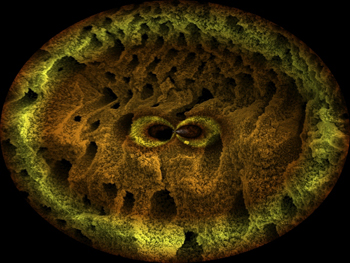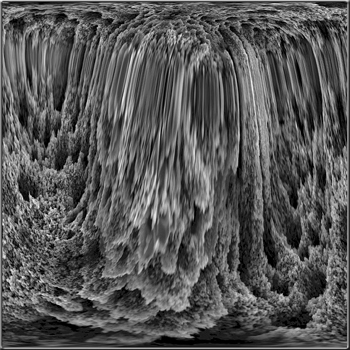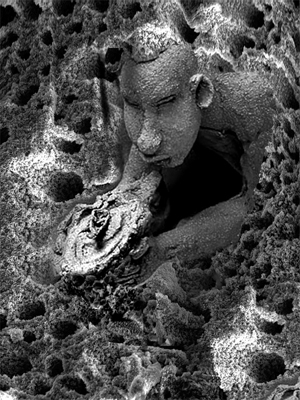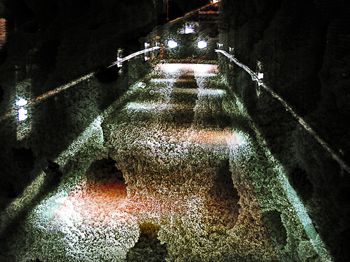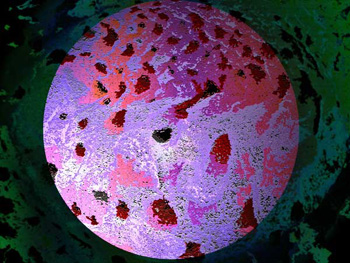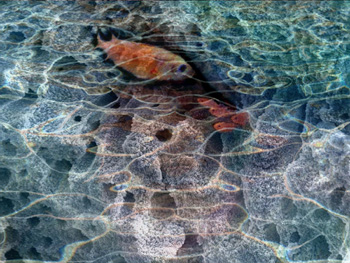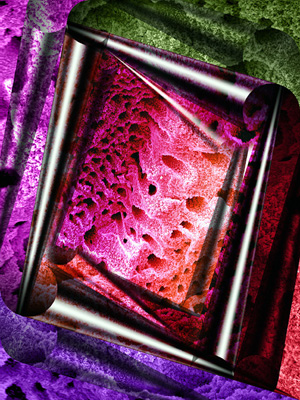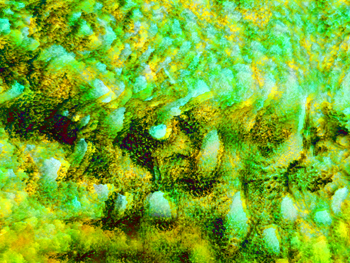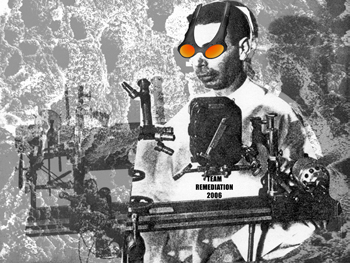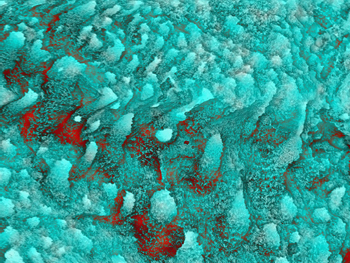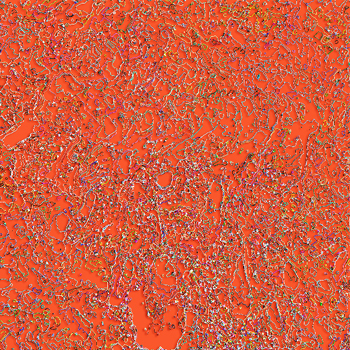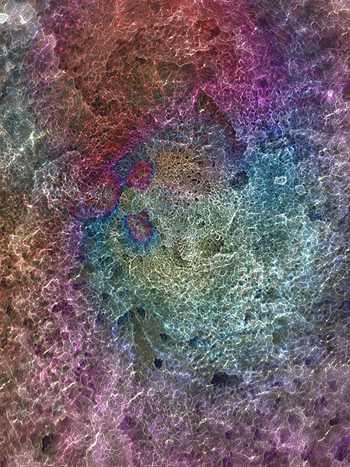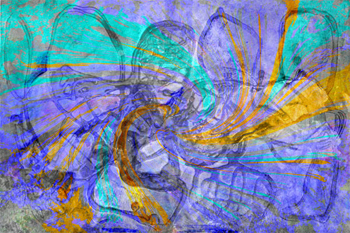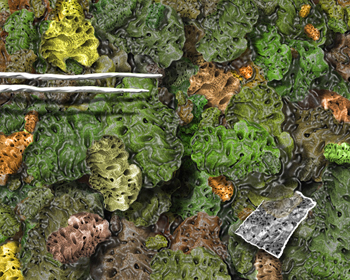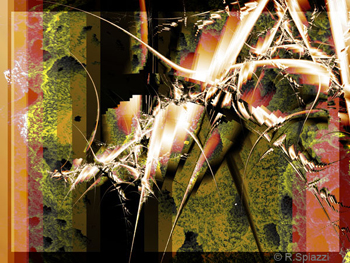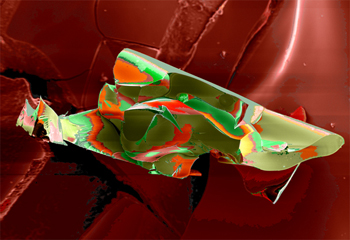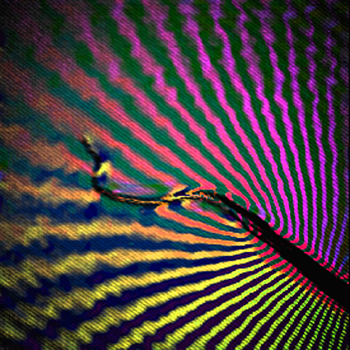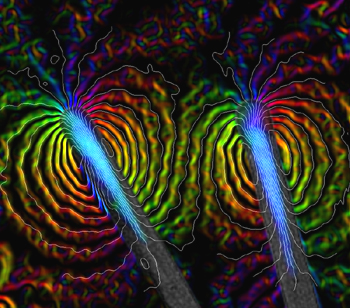Wednesday, February 28, 2007
Picture of the day
From NanoArt 2006. © Copyright Rense Andries Posthumus (click to see larger version)
NANOART is a new art discipline related to micro/nanosculptures created by artists/scientists through chemical/physical processes and/or natural micro/nanostructures that are visualized with powerful research tools like Scanning Electron Microscope and Atomic Force Microscope.
NanoArt could be for the 21st Century what Photography was for the 20th Century. We live in a technological society, in a new Renaissance period, and there is no reason for Arts to stay away from Technology. NanoArt is the expression of the New Technological Revolution and reflects the transition from Science to Art using Technology.
See all of Rense Andries Posthumus' NanoArt 2006 entries here, or visit the artist's website.
Please contact me if you would like to submit an image. (rocky at bir-consulting.com)
Quote of the day
Read the entire article at Omni Magazine.
Interview with Jennifer Fonstad
RR: What is your definition of nanotechnology?
More than just a scale of measurement, nanotechnology harnesses and exploits the many unique characteristics of working at the nanoscale. The capacity to manipulate and control matter at the atomic level was driven by the development of tools such as the atomic force microscope (AFM). As more tools enable that manipulation, technologists across a wide spectrum of industries use these capabilities in truly unique and disruptive ways in their business.
RR: Overall, what do you like about nano as an investment area?
We see significant opportunity in materials science and in the manipulation of matter at the atomic scale. Catalyzed by critical tools such as the AFM and sequencing of the human genome, these advances promise to enable a host of new applications that are based on the often unique properties that are exhibited at such a small size. Carbon nanotubes, for example, are stronger than steel, highly conductive, and are precisely ordered. Far from being scientific curiosities, these structures may enable a new generation of nonvolatile memory, which is the focus of one of our portfolio companies, Nantero.
Read the entire interview here
Tuesday, February 27, 2007
Picture of the day
From NanoArt 2006. © Copyright Dolores Glover Kaufman (click to see larger version)
NANOART is a new art discipline related to micro/nanosculptures created by artists/scientists through chemical/physical processes and/or natural micro/nanostructures that are visualized with powerful research tools like Scanning Electron Microscope and Atomic Force Microscope.
NanoArt could be for the 21st Century what Photography was for the 20th Century. We live in a technological society, in a new Renaissance period, and there is no reason for Arts to stay away from Technology. NanoArt is the expression of the New Technological Revolution and reflects the transition from Science to Art using Technology.
See all of Dolores Glover Kaufman's NanoArt 2006 entries here, or visit her website.
Please contact me if you would like to submit an image. (rocky at bir-consulting.com)
Quote of the day
~David Talbot, Technology Review link
Nanomanufacturing Conference & Exhibits
Advanced materials, Pt. I
These bits span the period December 30, 2006, through January 12, 2007.
ENTA (the European Nanotechnology Trade Alliance) announced a free and confidential service for UK companies. The service assists companies in reporting data on engineered nanoparticles to the UK government, in an effort to insure that the particles are developed safely.
SDCmaterials announced the appointment of Joseph R. Bronson to its Board of Directors.
Paul Hansma, Patricia Turner and Rodney Ruoff announced their paper “Optimized adhesives for strong, lightweight, damage-resistant, nanocomposite materials: new insights from natural materials.” Nanotechnology 18 (2007) 044026 (3pp).
NanoComp was featured in an article touting their nanotube advances. They have the ability to weave them into fibers and fabric; very attractive technologies for the military. (http://www.nanocomptech.com/)
Researchers at MIT and GKSS Research Center (Germany) announced shape-memory polymers that are able to change shape based on their temperature. (http://www.ncbi.nlm.nih.gov/entrez/query.fcgi?cmd=Retrieve&db=PubMed&dopt=Abstract&list_uids=17116879)
University of Minnesota researcher Andreas Stein (and team) reports that they have developed a new technique for creating nanoscopic cubes and spheres of silicon dioxide. They are now able to de-construct larger structures to get the shape they want. (http://www.chem.umn.edu/groups/stein/)
University of Dayton Research Institute announced a $15 million contract with the US military for composite-based armor for vehicles. They expect that if all goes well the new armor will be available next year. Companies involved include TPI Composites and Armor Holdings Inc. The materials they create for the military are expected to show up in civilian applications such as wind turbine blades, automobile bodies, containers, and other areas where light weight and high strength are essential. (http://www.udri.udayton.edu/)
“A team of researchers from ETH Zurich in Switzerland and Zhejiang University in PR China have demonstrated nanorobotic spot welding using single-crystalline copper-filled CNTs inside a transmission electron microscope (TEM).” (http://www.nanowerk.com/spotlight/spotid=1192.php)
University of Pennsylvania research physicist A.T. Charlie Johnson reports on nanotube/epoxy mixes that may lead to stronger glues. (http://www.lrsm.upenn.edu/~nanophys/)
Please contact me at rocky at bir-consulting.com for detailed reports on this or any other "nanotech" area, including advanced materials, nanomedicine, energy, cleantech, etc.
Monday, February 26, 2007
Picture of the day
From NanoArt 2006. © Copyright Susannah Israel (click to see larger version)
NANOART is a new art discipline related to micro/nanosculptures created by artists/scientists through chemical/physical processes and/or natural micro/nanostructures that are visualized with powerful research tools like Scanning Electron Microscope and Atomic Force Microscope.
NanoArt could be for the 21st Century what Photography was for the 20th Century. We live in a technological society, in a new Renaissance period, and there is no reason for Arts to stay away from Technology. NanoArt is the expression of the New Technological Revolution and reflects the transition from Science to Art using Technology.
See all of Susannah Israel's NanoArt 2006 entries here, or visit her website.
Please contact me if you would like to submit an image. (rocky at bir-consulting.com)
Quote of the day
~Zvi Yaniv, President and CEO, Applied Nanotech
Water water everywhere, Pt. I
It is estimated by the UN that over a billion people don’t have access to clean (safe) drinking water. The poignant quote used by UN water expert Brian Appleton is "The equivalent of 12 jumbo jets of children die everyday from sanitation-related diseases."
As I have done recently with investment and energy, I will recap news about nanotechnologies and water today, and again on a monthly basis.
These bits span the period December 30, 2006, through February 9, 2007.
The Bill and Melinda Gates Foundation's $450 million Grand Challenges in Global Health initiative covers projects such as curing blindness, purifying water, creating a vaccine for AIDS. (This note comes via an announcement for the Woodrow Wilson International Center for Scholars event and webcast on Feb. 27th covering "challenges of ensuring that nanotechnology meets the specific health needs of Third World peoples")
Nano Science & Technology Institute (NSTI) is holding Cleantech 2007 May 20 – 24, 2007. Covering: BioEnergy, Non-Bio Renewable Energy, Clean Technologies, Business & Policy, Novel Cleantech Product Development, and Environmental issues.
Dais Analytic Corporation (PINKSHEETS: DLYT) announced pilot version of its N-Still ™ water desalination system. It is based on based on nano-structured polymer membranes which produce clean water from seawater. (http://www.daisanalytic.com/)
EPA awarded $5 million in safe drinking water grants to US universities. (see http://www.nanotech-now.com/news.cgi?story_id=19727)
Rice University researcher Cafer Yavuz and his team were mentioned in bot Forbes and Science magazines for their "Separation of arsenic found in water" project. The team uses nanoscale iron oxide to bind to the toxic material, and does so up to 1,000 times more effectively that today’s filters. (see http://media.rice.edu/media/NewsBot.asp?MODE=VIEW&ID=9032&SnID=1349621130)
Research and Markets announced their new report "Multiple Benefits of Nanotechnology Encourages Widespread Uptake in Water and Wastewater Treatment." (see http://www.nanotech-now.com/news.cgi?story_id=20139)
IBM announced that it was working on various projects, including using nanotechnology to improve water filtration.
Learn more at these links:
http://www.cleantech2007.org/
http://news.bbc.co.uk/hi/english/static/in_depth/world/2000/world_water_crisis/default.stm
http://waterwater.org/
Friday, February 23, 2007
Picture of the day
From NanoArt 2006. © Copyright Joe Nalven (click to see larger version)
NANOART is a new art discipline related to micro/nanosculptures created by artists/scientists through chemical/physical processes and/or natural micro/nanostructures that are visualized with powerful research tools like Scanning Electron Microscope and Atomic Force Microscope.
NanoArt could be for the 21st Century what Photography was for the 20th Century. We live in a technological society, in a new Renaissance period, and there is no reason for Arts to stay away from Technology. NanoArt is the expression of the New Technological Revolution and reflects the transition from Science to Art using Technology.
See all of Joe Nalven's NanoArt 2006 entries here, or visit his website.
Please contact me if you would like to submit an image. (rocky at bir-consulting.com)
Quote of the day
~Stacy Lawrence
~From Nanotechnology: enabling technologies for Australian innovative industries
FutureCar, Pt III
Today I watched the third of 4 programs (I had previously thought that there were only three parts), this one titled “The Fuel.” The program covered these technologies:
Bio-diesel
Ethanol
Hybrids
Hydrogen/fuel cell (could also power your home)
Hydrogen-electric
Hydrogen-solar
Electric
Solar
Compressed air
And featured these future vehicles:
GM Skateboard (link), with interchangeable bodies and powered by a fuel cell
Aero X (link), which will use 100% ethanol fuel
Attack (link), biodiesel powered, soon to be hybridized with an electric motor
Tesla (link), an electric car, capable of 0 – 6- mph in ~4 seconds, with a 250 mile range. Costs ~$5 to recharge.
t-zero (link), also electric
MDI (link), powered by compressed air
Eclectic, solar powered
As was the case with the previous two programs, car enthusiasts will love this show, as will those that study the future.
Nanotechnology is not explicitly mentioned this time. As with the previous program, many technologies covered in this program will be enabled by nanotechnologies, and all of them enhanced, especially the fuel cell and composite materials.
Bottom line: worth the watch.
Next week I will cover the fourth in the series titled “The Brain.”
To learn more, visit discovery.com/futurecar
Wednesday, February 21, 2007
Picture of the day
From NanoArt 2006. © Copyright Fred Marinello (click to see larger version)
NANOART is a new art discipline related to micro/nanosculptures created by artists/scientists through chemical/physical processes and/or natural micro/nanostructures that are visualized with powerful research tools like Scanning Electron Microscope and Atomic Force Microscope.
NanoArt could be for the 21st Century what Photography was for the 20th Century. We live in a technological society, in a new Renaissance period, and there is no reason for Arts to stay away from Technology. NanoArt is the expression of the New Technological Revolution and reflects the transition from Science to Art using Technology.
See all of Fred Marinello's NanoArt 2006 entries here, or visit his website.
Please contact me if you would like to submit an image. (rocky at bir-consulting.com)
Quote of the day
~Futurologist Peter Schwartz
Clean Energy, Pt. 1
The following is a snapshot of news for the period January 13 - 26, 2007.
Researchers at MIT have developed a lithium battery that can charge or discharge in about 10 minutes. (RR: this is actually “old news” in that the announcement was first made in February 2006. It has, however, been getting a lot of press lately, due in my opinion to the real potential of their discovery)
See http://web.mit.edu/newsoffice/2006/battery-hybrid.html for more.
The EU announced £36 billion for R&D into “areas ranging from information and communication technology to energy and space research.” Specifically, £2.3bn to nanotechnology and £1.5bn energy.
See http://education.guardian.co.uk/higher/research/notes/story/0,,1990832,00.html for more.
EPSRC awarded University of East Anglia £208,000 “to improve hydrogen storage in solid form using nanotechnology.”
See http://www.e4engineering.com/Articles/297749/Power+pack.htm for more.
“Industrial Nanotech, Inc. (Pink Sheets:INTK), a Company that specializes in nanotechnology innovation and product development, today announced that, at the request of the U.S. Government's Center For Integrated Nanotechnologies (CINT), the Company has agreed to expand the capabilities of its planned manufacturing facility in Albuquerque, New Mexico, to include the production of specialty advanced materials for certain undisclosed US Government agencies.”
See http://www.nanotech-now.com/news.cgi?story_id=19722 for more.
“GE Global Research, the centralized research organization of the General Electric Company (NYSE: GE), today announced a promising breakthrough in nanotechnology that provides a direct pathway to making nanoceramic materials from polymeric precursors. Developing processes and a greater understanding of nano-engineered ceramics could lead to future applications in aviation and energy, where products such as aircraft engines and gas turbines could one day achieve new levels of efficiency, reliability and environmental performance.”
See http://www.nanotech-now.com/news.cgi?story_id=19724 for more.
“A joint Japanese research group from the Central Research Institute of Electric Power Industry and the National Institute of Advanced Industrial Science and Technology has developed a solid oxide fuel cell (SOFC) that can operate with high efficiency at relatively low temperatures of around 500-650 C.”
See http://www.fuelcellsworks.com/Supppage6749.html for more.
Gov. Arnold Schwarzenegger announced $30 million for the Helios Project, “a $120 million research facility where experts in genetics, nanomaterials and other fields design new photovoltaic cells and harness the methods that nature uses in plants, insects and microbes to turn sunlight into energy.”
See http://www.santacruzsentinel.com/archive/2007/January/18/local/stories/04local.htm for more.
Advanced Diamond Technologies, Inc. (ADT) received $500,000 Phase IIB SBIR from the NSF for the continued development of diamond-enhanced mechanical seals for pumping applications. DOE estimates trillions of BTUs saved annually if the technology plays out.
See http://www.nanotech-now.com/news.cgi?story_id=19822 for more.
Luna Innovations Incorporated was awarded $4 million by the USAF for R&D, including next-generation solar cells.
See http://www.nanotech-now.com/news.cgi?story_id=19827 for more.
Oak Ridge National Laboratory is working to transform fuel for engines. They will study highly reactive metal nanoparticles. “With a modified engine and a tankful of metal, they predict that an average saloon car could travel three times as far as the equivalent petrol-powered vehicle.”
See http://www.centralchronicle.com/20070123/2301302.htm for more.
Plextronics, Inc., recieved $750,000 from the Sustainable Energy Fund (SEF) of Central Eastern Pennsylvania. Funds to go towards R&D on Organic solar cells.
See http://www.nanotech-now.com/news.cgi?story_id=19864 for more.
“The University of South Carolina will launch its 7-week long Citizens’ School of Fuel Cell and Hydrogen Technology (CSFC&HT) on Feb. 5.”
See http://www.techjournalsouth.com/news/article.html?item_id=2570 for more.
University of Minnesota Prof. Eray Aydil and his team are working on solar cells.
See http://www.twincities.com/mld/twincities/news/breaking_news/16545780.htm for more.
DayStar Technologies Inc., received $5 million. Daystar is a solar cell manufacturer. Investors include Michael Dura of Guilderland/PreX Capital Partners LLC, Millennium Partners LP, and others not announced.
See http://timesunion.com/AspStories/story.asp?storyID=557415&category=BUSINESS&BCCode=HOME&newsdate=1/26/2007 for more.
Industrial Nanotech announced order for Nansulate by JatroDiesel to insulate refineries.
See http://www.nanotech-now.com/news.cgi?story_id=19984 for more.
Please contact me at rocky at bir-consulting.com for detailed reports on this or any other "nanotech" area, including advanced materials, nanomedicine, energy, etc.
Tuesday, February 20, 2007
Picture of the day
From NanoArt 2006. © Copyright Vijay Kochar (click to see larger version)
NANOART is a new art discipline related to micro/nanosculptures created by artists/scientists through chemical/physical processes and/or natural micro/nanostructures that are visualized with powerful research tools like Scanning Electron Microscope and Atomic Force Microscope.
NanoArt could be for the 21st Century what Photography was for the 20th Century. We live in a technological society, in a new Renaissance period, and there is no reason for Arts to stay away from Technology. NanoArt is the expression of the New Technological Revolution and reflects the transition from Science to Art using Technology.
See all of Vijay Kochar's NanoArt 2006 entries here, or visit his website.
Please contact me if you would like to submit an image. (rocky at bir-consulting.com)
Quote of the day
~Jack Uldrich, Author of Investing in Nanotechnology
~Jeffrey Sachs, director of the Earth Institute at Columbia University
~Mauro Ferrari, Ph.D., Professor of nanotechnology at the University of Texas Health Science Center
Show me the money, Pt. II
Here is a list of some of the investments going to "nanotech" companies, universities, and VC funds, for the 2-week period between January 27, 2007 and February 9, 2007.
Why did I put nanotech in quotes? Because the definition of nanotechnology remains elusive at best, and is often purposefully misapplied to fit the self-promotional goals of some companies who may not actually be working with nanoscale materials. The listings below are all "legit" nanotech.
Given the importance of investing, I will revisit this topic at least once a month.
--Alliance of Angels invested $5.8 million in 31 companies in 2006. Modumetal received funding. Websites: http://www.allianceofangels.com/ & http://www.modumetal.com/ (appears to be under construction)
--API Nanotronics Corp. buys National Hybrid Inc. and its subsidiary Pace Technology Inc. for $9.75 million. Website: http://www.apinanotronics.com
--Analytical Nano Technologies (ANT) raised £450,000 from private equity sources.
--$300 million to develop an international nanotechnology facility (amount requested by NY Gov. Eliot Spitzer).
--China jumps to second place in terms of overall government investment in nanotechnology in 2006 with $1.1 billion (the US was at $1.57 b).
--Emergency Filtration Products will place up to $1.65 million (in common stock) with two investors. Website: http://emergencyfiltration.com
--US President Bush asked Congress for $1.45 billion for nanotechnology for FY 2008, up 4.2% from 2007.
--NIST may get as much as a $50 million increase for FY 2007 for physical science programs and nanotechnology research. Website: http://www.nist.gov/
--NanoMed Pharmaceuticals announced second closing of Series A Convertible Preferred Stock investment by SWMF Life Science Venture Fund (amount not disclossed). Websites: http://www.nanomedpharm.com/ & http://www.southwestmichiganfirst.com/VentureFund.cfm
-- NanoQuébec budgets nearly $700,000 for eight nanotechnology research projects. Funding partners, NSERC, the NRC and Precarn. Website: http://www.nanoquebec.ca/
Nanotech investing events of interest:
Towards Finnish – Russian cooperation in commercializing nanotechnologies
Feb 8, 2007
http://www.swbusiness.fi/portal/87/?view=16623
Please contact me at rocky at bir-consulting.com for detailed reports on this or any other "nanotech" area, including advanced materials, nanomedicine, energy, etc.
Monday, February 19, 2007
Picture of the day
From NanoArt 2006. © Copyright Eva Lewarne (click to see larger version)
NANOART is a new art discipline related to micro/nanosculptures created by artists/scientists through chemical/physical processes and/or natural micro/nanostructures that are visualized with powerful research tools like Scanning Electron Microscope and Atomic Force Microscope.
NanoArt could be for the 21st Century what Photography was for the 20th Century. We live in a technological society, in a new Renaissance period, and there is no reason for Arts to stay away from Technology. NanoArt is the expression of the New Technological Revolution and reflects the transition from Science to Art using Technology.
See all of Eva Lewarne's NanoArt 2006 entries here, or visit her website.
Please contact me if you would like to submit an image. (rocky at bir-consulting.com)
Quote of the day
~David Talbot link
Clean Technologies, Pt I
Investments in cleantech are rising. According to the Cleantech Venture Network, clean technologies investment was $1.6 billion in 2005, up 34.9% over 2004. In 2006 investment in cleantech was $2.9 billion, representing a 78% increase over 2005, and a 140% increase over 2004 ($1.2 b).
Why invest in cleantech? Bottom line: demand for energy is growing (think China), and supplies of traditional energy, especially oil, are not growing. Also, as the public becomes increasingly aware of the consequences of pollution, cleantech demand rises. According to Frost & Sullivan, wind, solar and “clean power” will rise from a combined market total of $13.5 billion in 2000 to an estimated $91.5 billion in 2012.
Where does nanotechnology (nanoscale materials) come in? Many “clean” technologies are either enhanced by nanotechnologies or enabled by them. For instance, consider “nanomagnets” that could help treat arsenic-contaminated water (1), concrete treated with nanoscale titanium dioxide that reduces auto pollution (2), nanotechnology-enabled solar cells that become efficient enough to compete with traditional energy generation methods (some say we’ll see these in less than 5 years), and the use of materials that will greatly reduce weight (think automobile bodies and components) while at the same time increasing strength (already happening). There are many other examples, and many new ones added every day. The promise of nanotech-enabled cleantech is huge.
Here is a tidbit for you to consider:
“The Cleantech Venture Network forecasts that cleantech venture capital investment opportunities for major institutional investors globally through 2009 are estimated at $17 billion, with $10 billion in North America, $5 billion in Europe and $2 billion for the rest of the world. Cleantech Venture Network research has also shown that for every $100 million invested into venture-backed companies, 2,700 new jobs are created and the overall economy receives a 5x positive impact in related economic growth.”
From: Institutional Investors Surpass $1 B Clean Technology Investment Goal http://www.renewableenergyaccess.com/rea/news/story?id=46126
Want to learn how your company can take advantage of this trend? Visit bir-consulting.com.
(1) http://www.technologyreview.com/read_article.aspx?id=17776&ch=nanotech
(2) http://www.renewableenergystocks.com/CL/News/Valuing_Clean_Nanotech.asp
Friday, February 16, 2007
Picture of the day
From NanoArt 2006. © Copyright Bjoern Daempfling (click to see larger version)
NANOART is a new art discipline related to micro/nanosculptures created by artists/scientists through chemical/physical processes and/or natural micro/nanostructures that are visualized with powerful research tools like Scanning Electron Microscope and Atomic Force Microscope.
NanoArt could be for the 21st Century what Photography was for the 20th Century. We live in a technological society, in a new Renaissance period, and there is no reason for Arts to stay away from Technology. NanoArt is the expression of the New Technological Revolution and reflects the transition from Science to Art using Technology.
See all of Bjoern Daempfling's NanoArt 2006 entries here, or visit his website.
Please contact me if you would like to submit an image. (rocky at bir-consulting.com)
Quote of the day
~Mihail C. Roco, Senior adviser for nanotechnology to the National Science Foundation and a key architect of the National Nanotechnology Initiative link
FutureCar, Pt II
Today I watched the second of 3 programs, this one titled “The Body.” The program covered these technologies:
* the GM Skateboard (link), with interchangeable bodies and powered by a fuel cell
* advanced composites
* carbon nanotube enhanced tires (1)
* the Tweel (Iink), Naro (link) and Carver (link)
* VR for design and testing, and the use of haptics
* Urban vehicles to combat congestion
Again, car enthusiasts will love this show, as will those that study the future.
As you see from the list above, nanotechnology is explicitly mentioned this time. As with the previous program, many technologies covered in this program will be enabled by nanotechnologies, and all of them enhanced.
(1) Visit the websites of Andrew R. Barron and James Tour
Bottom line: worth the watch.
Next week I will cover the third in the series titled “The Fuel.”
To learn more, visit discovery.com/futurecar
Thursday, February 15, 2007
Picture of the day
From NanoArt 2006. © Copyright Gregory O'Toole (click to see larger version)
NANOART is a new art discipline related to micro/nanosculptures created by artists/scientists through chemical/physical processes and/or natural micro/nanostructures that are visualized with powerful research tools like Scanning Electron Microscope and Atomic Force Microscope.
NanoArt could be for the 21st Century what Photography was for the 20th Century. We live in a technological society, in a new Renaissance period, and there is no reason for Arts to stay away from Technology. NanoArt is the expression of the New Technological Revolution and reflects the transition from Science to Art using Technology.
See all of Gregory O'Toole's NanoArt 2006 entries here, or visit his website.
Please contact me if you would like to submit an image. (rocky at bir-consulting.com)
Quote of the day
~Ford Motor Co.
"Whether you are the CEO of a multibillion-dollar semiconductor company, a heart surgeon, an automobile repair shop manager, a drug company representative, a psychiatrist, the division manager of a multimillion-dollar paint company, or even a house painter, nanotechnology is going to impact you."
FutureCar
Today I watched the first of 3 programs, this one titled “The Extremes.” The program covered these technologies:
* battery (in a vehicle that reaches 325 mph)
* diesel (in a vehicle that gets 111 mpg at 140 mph)
* hydrogen
* safety
* automated public transport
* big rigs
* and of course, the Moller SkyCar (every show on the future of transpiration includes it, although it does not seem to have convinced many of it’s viability)
Car enthusiasts will love this show, as will those that study the future.
So, where does nanotechnology come in? It doesn’t, at least not directly. However, anyone familiar with the technologies covered in this program know that most of them will be enabled by nanotechnologies, and all of them enhanced.
Bottom line: worth the watch.
Tomorrow I will cover the second in the series titled “The Body.”
Wednesday, February 14, 2007
Picture of the day
From NanoArt 2006. © Copyright Lisa Black (click to see larger version)
NANOART is a new art discipline related to micro/nanosculptures created by artists/scientists through chemical/physical processes and/or natural micro/nanostructures that are visualized with powerful research tools like Scanning Electron Microscope and Atomic Force Microscope.
NanoArt could be for the 21st Century what Photography was for the 20th Century. We live in a technological society, in a new Renaissance period, and there is no reason for Arts to stay away from Technology. NanoArt is the expression of the New Technological Revolution and reflects the transition from Science to Art using Technology.
See all of Lisa Black's NanoArt 2006 entries here, or visit her website.
Please contact me if you would like to submit an image. (rocky at bir-consulting.com)
Quote of the day
~Behfar Bastani, Dennis Fernandez link
Investing in nanotech, another interview
RR: Given the vast plethora of nano-this and nano-that companies, how does one go about investing in a company with real potential?
First of all understand the technology and the business model. The key point is that Nanotechnology is a multidisciplinary enabling technology, and cuts horizontally across the traditional vertical markets, and interfaces with many traditional business sectors. The technology may be hard work, but if you are investing in things you don t understand, you'll have some explaining to do later. With the "Nanotechnology Opportunity Report" we have provided a framework for investors to understand how opportunities can arise at the intersection of the horizontal technology and the vertical market axes. With publications like the X Report we widen the focus and look at the intersection between info, bio and nano technology.
Secondly, consider the impact. Think about electricity enabling street lighting, telegraph, telephone, electronics and the internet. This all stemmed from the understanding that by applying a voltage you could make an electric current flow along a conductor, and resulted in the creation of new and mainly unforeseen industries. So the massage is, watch the impact of the technology, not the technology per se. Remember that producing silicon wafers is a nice little business, but the real value add comes from their application by companies like Intel, Dell & Microsoft.
Thirdly, if you can do the above, look at the team behind the business. Nanotechnology is very technical compared to internet investments, and many of the current crop of entrepreneurs have a highly technical background. Ask yourself whether they are the right people to make the transition from the lab to the boardroom.
RR: Is there any one nanoscale technology of special interest to you or your firm?
Our key goal is in providing rational information about nanotechnology, so you could say that we are interested in every aspect of the technology. At the moment, there is no global or comprehensive overview of nanotechnology apart from the "Nanotechnology Opportunity Report" and TNT Weekly. If you want to invest in nanotechnology, you need to be up to date on a global scale; it is the only way to spot the trends and opportunities. Nanotechnology is changing on a daily basis, and unless you know what your potential competitors in Europe, China and Japan are doing right now, you might make some very costly mistakes!
Read the entire interview, here:
http://www.nanotech-now.com/tim-harper-interview-042002.htm
Tuesday, February 13, 2007
Picture of the day
From NanoArt 2006. © Copyright Diane Vetere (click to see larger version)
NANOART is a new art discipline related to micro/nanosculptures created by artists/scientists through chemical/physical processes and/or natural micro/nanostructures that are visualized with powerful research tools like Scanning Electron Microscope and Atomic Force Microscope.
NanoArt could be for the 21st Century what Photography was for the 20th Century. We live in a technological society, in a new Renaissance period, and there is no reason for Arts to stay away from Technology. NanoArt is the expression of the New Technological Revolution and reflects the transition from Science to Art using Technology.
See all of Diane Vetere's NanoArt 2006 entries here, or visit her website.
Please contact me if you would like to submit an image. (rocky at bir-consulting.com)
Quote of the day
The US Nanotechnology Environment - Where is the business?
~Senator Gordon Smith (R-OR)
link
Investing In Nanotech
RR: What is your definition of nanotechnology?
Harris & Harris Group, Inc. invests in tiny technologies, which we define as nanotechnology, Microsystems and microelectromechanical systems (MEMS). Our primary focus is nanotechnology. One must remember that we invest in what we hope are good business opportunities, not definitions. It just so happens that we focus on business opportunities that leverage proprietary technologies that happen to be at the nanoscale. With that in mind, we tend to define nanotechnology as the creation of useful materials, devices and systems through the engineering of properties at the nanoscale and the unique properties and phenomena observed in this size regime.
RR: What are the typical sources for deals? Outside referrals? Referrals by associates? Conferences & events networking? Blind submissions by Internet or mail? Other?
We have looked at over 225 business opportunities in 2004. These opportunities come from research institutions, other venture capital groups, the companies themselves, our directors and associates and through unsolicited channels. I believe that because we are active in the space, nanotechnology companies know that their plans will have an audience from Harris & Harris Group. Access to quality deal flow is essential for venture investors, and it is important to remember that we have seen over 225 business opportunities but only invested in five in 2004.
RR: Overall, what do you like about nano as an investment area?
I like the opportunity to invest in the research coming out of a few of the premier research labs in the country in an emerging area of science that often provides for broad intellectual property coverage before too much capital chasing too few deals has led to capital market myopia. Just as in the early days of biotechnology, the quality of people is astounding, and I spend most of my days being the dumbest person in the room, which means I am always learning something.
Read the entire interview, here:
http://www.nanotech-now.com/products/nanonewsnow/issues/017/017.htm#main
Monday, February 12, 2007
Picture of the day
From NanoArt 2006. © Copyright Ursula Freer (click to see larger version)
NANOART is a new art discipline related to micro/nanosculptures created by artists/scientists through chemical/physical processes and/or natural micro/nanostructures that are visualized with powerful research tools like Scanning Electron Microscope and Atomic Force Microscope.
NanoArt could be for the 21st Century what Photography was for the 20th Century. We live in a technological society, in a new Renaissance period, and there is no reason for Arts to stay away from Technology. NanoArt is the expression of the New Technological Revolution and reflects the transition from Science to Art using Technology.
See all of Ursula Freer's NanoArt 2006 entries here, or visit her website.
Please contact me if you would like to submit an image. (rocky at bir-consulting.com)
Quote of the day
~Gordon Smith (R-OR)
~James Canton, Ph.D. CEO, Institute for Global Futures
~Mike Honda (D-CA)
Behind the Buzzword
What working in nanotechnology really means
There's no doubt that a career in nanotechnology would be both interesting and challenging. But what, exactly, is nanotechnology--and what would a career in nanotechnology actually be like?
Essentially the ability to control the atomic and molecular building blocks of material, nanotechnology will be applied to change or create chemical, electronic, magnetic, optical, and structural properties in materials or nanostructures. These materials will then be assembled and/or utilized for new processes and devices. Nanotechnology is an enabling technology that will be used in many applications across many industries, including computing, communication, transportation, energy, materials, manufacturing, cosmetics, healthcare, biotechnology, pharmaceuticals, the environment.
You can therefore work in nanotechnology in a range of settings. If you are not doing basic discovery work in one of the many university-based or government-funded research programs, you could be working in a biotechnology company on a nanoparticle-based molecular system for detecting biological warfare agents or fabricating a miniature terahertz laser for medical diagnostics. The adoption of nanotechnology-based applications by large pharmaceutical and biotechnology companies, as well as diagnostic companies, means that you could have the opportunity to work on a new therapeutic drug or a novel drug delivery process.
To read the entire article, visit http://www.nanotech-now.com/products/nanonewsnow/issues/014/014.htm#Pamela-Bailey
Friday, February 9, 2007
Picture of the day
From NanoArt 2006. © Copyright Chris Marshall (click to see larger version)
NANOART is a new art discipline related to micro/nanosculptures created by artists/scientists through chemical/physical processes and/or natural micro/nanostructures that are visualized with powerful research tools like Scanning Electron Microscope and Atomic Force Microscope.
NanoArt could be for the 21st Century what Photography was for the 20th Century. We live in a technological society, in a new Renaissance period, and there is no reason for Arts to stay away from Technology. NanoArt is the expression of the New Technological Revolution and reflects the transition from Science to Art using Technology.
See all of Chris Marshall's NanoArt 2006 entries here, or visit her website.
Quote of the day
~Jack Uldrich link
"A major environmental, medical or safety problem-real or bogus-with a product or application that's labeled 'nanotechnology'- whether it actually is nanotechnology or not-could dampen public confidence and financial investment in nanotechnology's future, and could even lead to unwise regulation. We should not let this happen."
~Neal Lane, former science advisor to U.S. President Bill Clinton
Show me the money, Pt. I
Here is a list of some of the investments going to "nanotech" companies, universities, and VC funds, for the 2-week period between January 13, 2007 and January 26, 2007.
Why did I put nanotech in quotes? Because the definition of nanotechnology remains elusive at best, and is often purposefully misapplied to fit the self-promotional goals of some companies who may not actually be working with nanoscale materials. The listings below are all "legit" nanotech.
Given the importance of investing, I will revisit this topic at least once a month.
--DayStar Technologies Inc., $5 million. Daystar is a solar cell manufacturer. Investors in this round: Michael Dura of Guilderland/PreX Capital Partners LLC, Millennium Partners LP, and others not announced. Website: http://www.daystartech.com/
--Medical Academy (AM) in Warsaw, €100m for the construction of a Pre-Clinical Research and Technology Centre (CEPT). The link here is to their research in nanobiotechnology (nanomedicine) applications.
--Dr. Eric Davidson's laboratory at the California Institute of Technology, $255,000 annually for three years by Arrowhead Research Corporation. The link here is to his research in nanobiotechnology (nanomedicine) applications. Website: http://www.its.caltech.edu/~mirsky/ehdavidson.htm
--Spacehab Inc. president and CEO Thomas B. Pickens III announced plans for nanotech venture fund, with a goal of raising $100 million in the first phase. Funds will support Texas-based nanotech companies.
--The EU FP7 budget for years 2007 through 2012 is €50bn, with €3.5bn (~$4.5bn) dedicated to nanotechnologies.
--Plextronics, Inc., $750,000. Funds to go towards R&D on Organic solar cells. Investor: Sustainable Energy Fund (SEF) of Central Eastern Pennsylvania. Website: http://www.plextronics.com
--NanoQuébec will provide $2 million to fund 18 proposals from universities and private companies. Website: http://www.nanoquebec.ca/
--South Korean Government, 52 bn won (~$520 million) into "nanotechnology sectors."
--Xradia, $4 million. Xradia is a tools manufacturer. Investor: Harris & Harris. Website: http://xradia.com/
Please contact me at rocky at bir-consulting.com for detailed reports on this or any other "nanotech" area, including advanced materials, nanomedicine, energy, etc.
Staying with the investing theme, a short interview with Peter Hebert, Lux Capital
RR: When you talk to someone who wants to know about nanotech companies or technologies to invest in, what are some of the things you stress with them?
What makes nanotech unique is that it provides a new scientific toolkit to address industry pain points and develop new commercial applications. Investors are most interested in technologies that solve existing problems or drive new product demand. Because of the differentiated properties at the nanoscale, nanotechnology offers the ability to do both.
RR: Are there any media-hyped or investment guru-hyped technologies or companies that you steer potential investors away from?
We've been wary of any new technologies that appear disconnected from market needs. Without deep knowledge of industry's needs and requirements (e.g. inexpensive volume manufacturing), most of these promising technologies will always loom on the horizon and never on product shelves.
RR: For someone who is looking to invest in the next 2 - 5 years, are there technologies or companies that you suggest are worth watching?
Over the next 2-5 years, I'd look for some big breakthroughs in using nanomaterials for energy, electronics and life sciences applications.
And with Jack Uldrich, NanoVeritas Group
RR: When you talk to someone who wants to know about nanotech companies or technologies to invest in, what are some of the things you stress with them?
Patience. Nanotech is a long-term trend. Don't expect to get rich overnight!
RR: Are there any media-hyped or investment guru-hyped technologies or companies that you steer potential investors away from?
I advise investors not to trust company spokespeople. Their interests are not the same as yours. Do your due diligence and take everything they say with a grain of salt. Altair and NVE are but just two examples of companies that I would encourage investors to be careful of.
RR: For someone who is looking to invest in the next 2 - 5 years, are there technologies or companies that you suggest are worth watching?
Personally, I am excited about Starpharma's dendrimer technology in the next 3 to 5 years. Shorter term, I like Headwaters' nano-catalyst technology.
Nanotech investing events of interest:
Nano Nexus 2007 is a new nanotechnology event with an emphasis on education for all the critical players in nanotechnology commercialization universities, government, industry and the investment community. April 2-4, 2007 Website: http://www.nanonexus.org/
NanoQuebec NANO2007 & US Showcase & VC Coaching Program. February 7, 2007
http://nanoquebec.ca/nanoquebec_w/site/explorateur.jsp?currentlySelectedSection=494
Thursday, February 8, 2007
Picture of the day
From NanoArt 2006. © Copyright J. D. Jarvis (click to see larger version)
NANOART is a new art discipline related to micro/nanosculptures created by artists/scientists through chemical/physical processes and/or natural micro/nanostructures that are visualized with powerful research tools like Scanning Electron Microscope and Atomic Force Microscope.
NanoArt could be for the 21st Century what Photography was for the 20th Century. We live in a technological society, in a new Renaissance period, and there is no reason for Arts to stay away from Technology. NanoArt is the expression of the New Technological Revolution and reflects the transition from Science to Art using Technology.
See all of J. D. Jarvis' NanoArt 2006 entries here, or visit his website.
Quote of the day
~Kevin G. Coleman, Ph.D., Senior Fellow with the Technolytics Institute
Commenting on how society can cope with the massive changes that will result from our understanding of the nanoscale, Dr. Robert D. Atkinson (1) said: "We should not use the precautionary principle as our guide, nor should we just ignore the potential problems. We should go forward with research on nano while at the same time go forward with research into the potential problems from nano and the solutions to them."
(1) Vice President and Director of the Technology and New Economy Project, Progressive Policy Institute (link). Author, "The Past and Future of America's Economy: Long Waves of Innovation that Power Cycles of Growth"
"Lurking just beyond the horizon, there is a globe-spanning, international business-changing, society-altering tsunami - from which we're catching the first waves, now. Companies, governments, and institutions are already being forced to consider a blinding rate of technological change; many finding themselves woefully unprepared. The rate at which the waves hit will likely increase, as technology advances on a double-exponential curve. Those that don't take the first preparatory steps now for massive changes soon better find someone who can, before they find themselves taking those first steps down the path towards the "dustbin of history."
~Rocky Rawstern, Editor, Nanotechnology Now (nanotech-now.com). Sept. 2003
A Transparent Society, Maybe
“…'next generation' computer chips which will see processors with mind-boggling memories the size of a grain of sand.”
“The new technology will have military uses with tiny spy planes the size of flies able to collect and send back information over hundreds of miles.” link
OK, those were some semi-random headlines gleaned from recent nanotech news. Semi-random since I was looking for technologies that will enable ubiquitous surveillance, but picked from amongst dozens of others that fit the “nano” mold. And keep in mind that there have been literally hundreds of similar improvements in various supporting technologies in the past few years. It seems probable that improvements along these lines will continue, and the rate at which these advances become part of “today’s technologies” will continue to increase.
So, we’ve got technologies that reduce the size of sensors, technologies that reduce the size of sensor batteries, and technologies that reduce the size and increase the capacity of memory modules. What does it all mean? It means that sometime in the not-to-distant future, perhaps 5 to 10 years from now, we will have the ability to construct cheap (nearly free) sensors that will be difficult if not impossible for the human eye to detect. These sensors will have the ability to detect everything from conversations to chemicals, and send their findings hundreds, if not thousands of miles (using satellite uplinks) to whoever is monitoring them.
What do we do about it? I don’t know. What I do know is that this “possible future” will be an issue, and probably one of the most socially disruptive of all the near term “nanotechnologies.” (A better term is “nanotechnology-enabled technology”)
In closing, I’d like to refer back to a note I made earlier about David Brin’s compelling argument in The Transparent Society: Will Technology Force Us to Choose Between Privacy and Freedom? Brin argues for a more open society; “one in which those in power would be required to adhere to the same "openness" standards as their constituents, where the authorities are monitored as well as monitoring.” Maybe this is the answer; I don’t know, but it is a place to start the debate; a debate that needs to begin soon, and needs to include all stakeholders.
Wednesday, February 7, 2007
Picture of the day
From NanoArt 2006. © Copyright Renata Spiazzi (click to see larger version)
NANOART is a new art discipline related to micro/nanosculptures created by artists/scientists through chemical/physical processes and/or natural micro/nanostructures that are visualized with powerful research tools like Scanning Electron Microscope and Atomic Force Microscope.
NanoArt could be for the 21st Century what Photography was for the 20th Century. We live in a technological society, in a new Renaissance period, and there is no reason for Arts to stay away from Technology. NanoArt is the expression of the New Technological Revolution and reflects the transition from Science to Art using Technology.
See all of Renata Spiazzi's NanoArt 2006 entries here, or visit her website.
Quote of the day
~Behfar Bastani, Dennis Fernandez link
NanoArt
Cris’ personal website is absolutearts.com. Of particular interest to regular readers and visitors is the section on NanoArt. There you will find examples of art created from science, using technology.
As Cris puts it: “My art is a reflection of the technological movement. I consider NanoArt to be a more appealing and effective way to communicate with the general public and to inform people about the new technologies of the 21st Century. NanoArt is intended to make the public aware of Nanotechnology and how will this impact our lives.”
By day, Cris is a materials scientist and manager of the analytical laboratory at Caleb Technology. This means that he understands nanoscale materials. What he’s trying to do with NanoArt is to help the public understand nanotechnology. He says that he thinks people are unaware of the benefits that nanotechnologies could bring, instead focusing on the perceived dangers. I believe he’s on the right track; many people will probably find that through art, they will be better able to get a handle on advanced science.
As a science writer, I am fascinated by the way Cris uses a scanning electron microscope to create the underlying images, which he then manipulates with PhotoShop to create stunning, three dimensional final products.
As an aspiring artist myself, I find myself drawn into and captivated by his artwork.
His other project is the NanoArt competition. You can view, and are encouraged to vote for, 71 images from 22 artists. While there are many outstanding examples of “science turned art,” my favorite is the one you see as the Picture of the day.
My favorite work by Cris is:
A nanosculpture created by freezing a tiny drop of colloidal graphite (graphite nanoparticles in a suspension) in Liquid Nitrogen at -196 deg C. The monochromatic scan has been painted digitally. (click to see larger version)
If you then visit his site or buy one of his images, please tell him I sent you.
Tuesday, February 6, 2007
Picture of the day
The image shows magnetic field lines around the end of an iron wire, which is magnetized along its length. The field of view is approximately 1µm. The image was acquired using electron holography in a field emission gun transmission electron microscope. (click to see full sized version)
Acknowledgments: John Thong, Ken Harada, Akira Tonomura, Tetsuya Akashi and Tsuyoshi Matsuda, Yoshihiko Togawa, Chris Boothroyd, Rafal Dunin-Borkowski.
Visit the University of Cambridge Department of Materials Science & Metallurgy Gallery.
I will post the others in this series over time. To see it all now, visit the Nanotechnology Now Gallery.
Quote of the day
~Jack Uldrich & Deb Newberry. From Next Big Thing Is Really Small: How Nanotechnology Will Change the Future of Your Business.
Interview with Judith Light Feather
The long-term vision involves programmable matter and molecular assembly of products whereby humans will move from their 'wage slave' survival mode to a more creative lifestyle that allows them time to learn and create. Everyone should have the same learning opportunities to develop skills and talents to their maximum ability, sharing the results with their neighbors and families. Intellectual property developed from humanity will have the value for exchange now given to mundane products. The properties of nanomaterials which repel dirt and grime, when put into building materials, flooring, glass, appliances and automobiles, will finally free mankind from many of the time consuming chores that take up their precious few leisure hours. Improved clothing and recreation equipment will enhance the lifestyles of society, along with more time to learn new skills and create new ideas for culture benefits.
RR: How can government and educational institutions address the need for significantly larger numbers of nano-educated college grads?
The problems in the universities, regarding the lack of students interested in science reflects back to our main education issues in elementary schools. Until our government leaders realize that the Department of Education was created with no authority to mandate curriculum on a national level, but are permitted to mandate National Testing on the sub-standard curriculum which local schools boards make the decisions to accept, nothing will change.
RR: If you could sit down with the leaders of every country and talk to them about the development of nanotechnology, what issues would you focus on?
We recently had this conversation with the leaders of Thailand and Vietnam concerning development of courses for education and the future technology. The first issue we focused on was types of education modules that would reach all ages and develop into a lifelong learning situation. Education is always first, then the research, then the technology. Culture was an important issue as each country strives to preserve their identity while becoming competitive in a global society. Communication between scientific disciplines and each other was also top on the list. The ability to form relationships and share information in friendship and trust was the result of this first effort.
To read the entire interview, visit:
http://www.nanotech-now.com/Judith-LightFeather-interview.htm
Monday, February 5, 2007
Picture of the day
The nanotubes were fabricated in the University of Cambridge Engineering department by Yasuhiko Hayashi, who grew them using a Cobalt-Palladium catalyst. This alloy remains present in the ends of the nanotubes, and is magnetic. The nanotubes you see here have a 70-100nm diameter. Characterisation of the magnetic properties was carried out by Ed Simpson and Takeshi Kasama using Electron Holography, a TEM technique which records the phase of an electron wave. The phase, being affected by any magnetic field the electron passes through, therefore records any information on the magnetic properties on the sample under investigation. From this, the magnetic induction maps you see here can be generated. The colours represent the direction and intensity of the field, and the contours, the magnetic field lines. It is an entirely quantitative technique, so as well as these images of the field, the magnetic moment, for instance, can be deduced too. (click to see full sized version)
Acknowledgments: Ed Simpson, Yasuhiko Hayashi, Takeshi Kasama and Rafal Dunin-Borkowski
Visit the University of Cambridge Department of Materials Science & Metallurgy Gallery.
I will post the others in this series over time. To see it all now, visit the Nanotechnology Now Gallery.
Quote of the day
~K. Eric Drexler: a researcher, author, and policy advocate focused on emerging technologies and their consequences for the future. He pioneered studies of productive nanosystems and their products (the still-theoretical field originally termed "nanotechnology").
2057 – A Review
First and foremost, LIFE WILL BE DIFFERENT! Nearly everything we do, nearly every experience we have, will be shaped by paradigm-shifting new technologies. Materials will be lighter, stronger, and functionalized. The way we work with information will be exponentially enhanced. Many things will be automated, including health monitoring and tracking. Should you choose, it will be an always-on interconnected society.
They also got right that privacy will be an issue. With the ever-decreasing size (and cost) and increasing functionality of sensors, it is absolutely believable that in 2057 we’ll be constantly surveiled, at home, at work, and in public. Is this a good or bad thing? I don’t know, although I tend to think it is something we should spend time considering, starting now. (1)
Screening, diagnosis, monitoring, treatment of disease, and emergency care will undergo a radical change in the next 50 years. Given the very rapid advances in the use of nanoparticles for medicine, I would be very surprised if by 2057 if cancers were not simple-to-treat short-term illnesses, like the common cold is today. In fact, I’d be surprised if this were not the case by 2020, given the pace of advances being made. (2)
What they got wrong
There was no mention of molecular manufacturing. My guess is they left it out because there is controversy surrounding the idea that we will soon be able to construct common objects using individual molecules (controversy which seems unreasonable given advances in nanoscale science). Omitting the likelihood that in 50 years we won’t have molecular manufacturing seems to suggest that they were avoiding the topic; there is ample science to support the idea that among the other advances depicted, molecular manufacturing should have been included.
Holographic pets: My friend (and futurist) Brian Wang says it this way: “I thought the holographic sharks would be visual pollution. They should have those only visible to the user. Feed the image to the retina or via some non-invasive communication feed to the brain. I also failed to see the economic benefits.” I agree. Can you imagine walking through a packed mall (will we still have them?) and everyone around you has a holographic projection following them?
Conspicuous by its absence was quantum computing (QC). As Brian Wang goes to great lengths to point out (in his blog) QC is happening now. When I asked him to speculate on near-future advances, he said “I think on the low end they should have thousands of qubits able to simulate thousands of quantum molecules (in the 3 to 5 year timeframe) against simulations of 50-100 molecules with similar precision.”
Hyper-efficient solar panels: This one seems pretty obvious to anyone tracking advances in this area. There are several technologies currently on the drawing board (or more precisely, in university and business labs) that look very promising. By promising I mean likely to achieve huge improvements in their sunlight-to-energy conversion rate. Today’s technologies allow for conversion rates that are almost good enough to compete toe to toe with coal, nuclear, and other traditional energy generation technologies. Were I a betting man, I’d place a large percentage of my dollars on photovoltaics (PV). In fact, of all the nanotechnologies, solar/PV is one of the areas where I will be placing my bets.
What I hope to see, or “wouldn’t it be nice, if?”
(And just as important, I also believe that these are likely, many of them earlier than 2057)
The Hand-comp (the 2057-version of the personal computer/cell phone/PDA)
Self-guided, networked cars
Custom-built organs from scratch
Space Elevator and tethered research stations
Smart Houses
Information transfer at predictable increases
Artificial blood
Things I am leery of, or “can’t we have all the rest, without this?”
An oil shortage that brings the US and China to the brink of war (and possibly beyond). How about, instead, we start funding alternate energy technologies at a rate equal to or exceeding that which goes towards supporting oil? As I said in my last post, can you imagine being free from the idiocy surrounding the use of petroleum?
In Closing
The last sentence on the 2057 “About the Show” page states: “This series is all about opening the window of our future based on science fact, not science fiction.”
Mostly I’d agree.
My bottom line in regards to this series: it was well worth the 3-hour watch. At worst, it will get more people asking questions about the technologies depicted; stimulating the debate by adding more stakeholders is a good idea. At best, it will get more people asking questions about the technologies depicted…
To learn more about possible futures, visit:
2005 BT Technology Timeline
And a nice collection at DMOZ http://dmoz.org/Society/Future/Predictions/
(1) David Brin presents an interesting and compelling argument with
The Transparent Society: Will Technology Force Us to Choose Between Privacy and Freedom (I highly recommend this book.)
Synopsis: David Brin, in The Transparent Society, acknowledges that privacy, as we know it, is being slowly eaten away day by day. Entire cities are falling under the watch of surveillance cameras; "nanny monitors" that allow parents to keep an eye on the people who are watching their children are becoming more common in households with children. However, instead of calling for restrictions on this surveillance, he argues for a more open society from both sides -- one in which those in power would be required to adhere to the same "openness" standards as their constituents, where the authorities are monitored as well as monitoring.
(2) According to the National Vital Statistics Report (Vol. 53, No. 15, February 28, 2005), 13 of the top 15 killers in the US are medical related. I would be very surprised to see any of the 13 medical reasons in the top 10 in 2057 as anything other than a minor contributing factor. See http://origin.cdc.gov/nchs/data/nvsr/nvsr53/nvsr53_15.pdf
Friday, February 2, 2007
Picture of the day
Acura FCX 2020 Le Mans
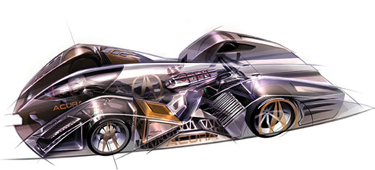
Hydrogen fuel cell; "100 percent recyclable" lightweight materials; "nanotechnology would be involved somehow."
Credit: LA Auto Show
link to full article
Quote of the day
2006 SME Nanomanufacturing Conference
It is the year 2030
Even if it is silent. Fuel cells will finally bring about the “quiet car.” No sound when it “starts up” and none (other than the advanced composite tires on the road) as it moves along. You will, however, be able to broadcast sound effects; give it the sound of a 1970 SS 454 Chevelle, or tune it to be a street racer, or… And you won’t be needing those keys; biometrics will allow your car to recognize you as long as your wrist-comp remains connected to your personal ‘net. Once you approach close enough for the stereoscopic cameras to “verify” you, your car will automatically unlock the doors, prep your specified seat position and controls, upload your destination coordinates, and await your verbal command to get moving. Oh yeah, unless your override, all commands will be verbal, except steering, acceleration, and braking when in manual mode.
Head out on the highway…
Well, OK, it’ll be a sensor-monitored and -controlled highway. While drivers from 2007 will recognize it as such, functionally it will be very different. For one, you won’t need to do the driving, your car (assisted by the highway network) will do the driving for you. You’ll get to catch up on your email, do your nails, or any one of a million other tasks, all the while the hwy-net does the work. Need to arrive at your destination in less time than the tourists? No problem, just tell your car to choose one of the faster lanes.
Lookin’ for adventure…
How about a 100-mile long public track that simulates various driving conditions, including 90-degree banks, obstacle courses, and virtual landscapes? It will have the same sensor system as the highway, above, but will allow you to control steering, braking, and speed. Your new 2030 Pontiac NanoScorpion (built in a factory by trillions of nanomachines) will take you around the track at speeds as high as your body is able take the G-forces. Should you choose the “high speed” section of the track, wearing your military-grade flight suit enables you to withstand much higher G’s.
Or whatever comes my way.
Coming your way in 2030 will be “cars” serving as dial-a-ride public transport, autonomous ambulances (as well as manned versions with built in diagnosis and treatment functionality), recreation-specific, recyclable, fuel cell powered wonders.
They will not pollute when running, or when being dismantled for recycling. The processes used to construct them (and their materials) will contribute less to the waste stream and to general pollution (and may even amount to zero waste). They will protect you in crashes that today would turn you into a tangled mess, while avoiding over 90% of those that early 21st Century drivers experienced. They will also be highly customizable to their owner’s tastes, and convertible from one format (such as “dune buggy”) to another (such as “highway cruiser”) by simply mounting a new body (ten minutes at a “body shop”) and reconfiguring the suspension.
It is 2030, and things have definitely changed
Can you imagine driving in any major city, and being able to safely breathe the air?
Can you imagine being free from the idiocy surrounding the use of petroleum? Free from the latest nut case with a bomb, a grudge, or a fervor-of-the-week membership.
Imagine tomorrow’s automotive technologies; technologies that will allow your “car” to perform feats of exquisite ballet; coming to fetch you, delivering you on time, and giving you time to relax or catch up on your stuff. Protecting you from harm and being gentle on the environment, drastically reducing humanity’s negative impact on the Earth.
Thursday, February 1, 2007
Picture of the day
Volkswagen Nanospyder
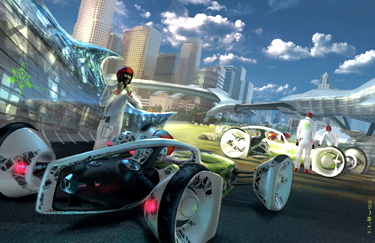
Recyclable; collision sensors; built by "billions of tiny nanomachines."
Credit: LA Auto Show



